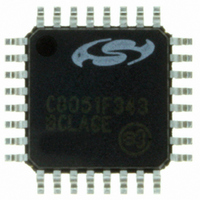C8051F343-GQ Silicon Laboratories Inc, C8051F343-GQ Datasheet - Page 88

C8051F343-GQ
Manufacturer Part Number
C8051F343-GQ
Description
IC 8051 MCU FLASH 32K 32LQFP
Manufacturer
Silicon Laboratories Inc
Series
C8051F34xr
Specifications of C8051F343-GQ
Program Memory Type
FLASH
Program Memory Size
32KB (32K x 8)
Package / Case
32-LQFP
Core Processor
8051
Core Size
8-Bit
Speed
48MHz
Connectivity
SMBus (2-Wire/I²C), SPI, UART/USART, USB
Peripherals
Brown-out Detect/Reset, POR, PWM, Temp Sensor, WDT
Number Of I /o
25
Ram Size
2.25K x 8
Voltage - Supply (vcc/vdd)
2.7 V ~ 3.6 V
Data Converters
A/D 21x10b
Oscillator Type
Internal
Operating Temperature
-40°C ~ 85°C
Processor Series
C8051F3x
Core
8051
Data Bus Width
8 bit
Data Ram Size
2304 B
Interface Type
I2C, SMBus, SPI, UART, USB
Maximum Clock Frequency
48 MHz
Number Of Programmable I/os
25
Number Of Timers
4
Operating Supply Voltage
2.7 V to 5.25 V
Maximum Operating Temperature
+ 85 C
Mounting Style
SMD/SMT
3rd Party Development Tools
KSK-SL-F34X, KSK-SL-TOOLSTICK, PK51, CA51, A51, ULINK2
Development Tools By Supplier
C8051F340DK
Minimum Operating Temperature
- 40 C
On-chip Adc
10 bit, 17 Channel
Package
32LQFP
Device Core
8051
Family Name
C8051F34x
Maximum Speed
48 MHz
Data Rom Size
128 B
A/d Bit Size
10 bit
A/d Channels Available
17
Height
1.4 mm
Length
7 mm
Supply Voltage (max)
3.6 V
Supply Voltage (min)
2.7 V
Width
7 mm
Lead Free Status / RoHS Status
Lead free / RoHS Compliant
For Use With
336-1748 - ADAPTER TOOLSTICK FOR C8051F34X770-1006 - ISP 4PORT FOR SILABS C8051F MCU
Eeprom Size
-
Lead Free Status / Rohs Status
Lead free / RoHS Compliant
Other names
336-1301
Available stocks
Company
Part Number
Manufacturer
Quantity
Price
Company:
Part Number:
C8051F343-GQ
Manufacturer:
Silicon Laboratories Inc
Quantity:
10 000
Company:
Part Number:
C8051F343-GQR
Manufacturer:
Silicon Laboratories Inc
Quantity:
10 000
C8051F340/1/2/3/4/5/6/7/8/9/A/B/C/D
9.3.
The CIP-51 includes an extended interrupt system supporting multiple interrupt sources with two priority
levels. The allocation of interrupt sources between on-chip peripherals and external inputs pins varies
according to the specific version of the device. Each interrupt source has one or more associated inter-
rupt-pending flag(s) located in an SFR. When a peripheral or external source meets a valid interrupt condi-
tion, the associated interrupt-pending flag is set to logic 1.
If interrupts are enabled for the source, an interrupt request is generated when the interrupt-pending flag is
set. As soon as execution of the current instruction is complete, the CPU generates an LCALL to a prede-
termined address to begin execution of an interrupt service routine (ISR). Each ISR must end with an RETI
instruction, which returns program execution to the next instruction that would have been executed if the
interrupt request had not occurred. If interrupts are not enabled, the interrupt-pending flag is ignored by the
hardware and program execution continues as normal. (The interrupt-pending flag is set to logic 1 regard-
less of the interrupt's enable/disable state.)
Each interrupt source can be individually enabled or disabled through the use of an associated interrupt
enable bit in an SFR (IE-EIE2). However, interrupts must first be globally enabled by setting the EA bit
(IE.7) to logic 1 before the individual interrupt enables are recognized. Setting the EA bit to logic 0 disables
all interrupt sources regardless of the individual interrupt-enable settings.
Some interrupt-pending flags are automatically cleared by the hardware when the CPU vectors to the ISR.
However, most are not cleared by the hardware and must be cleared by software before returning from the
ISR. If an interrupt-pending flag remains set after the CPU completes the return-from-interrupt (RETI)
instruction, a new interrupt request will be generated immediately and the CPU will re-enter the ISR after
the completion of the next instruction.
9.3.1. MCU Interrupt Sources and Vectors
The MCU supports multiple interrupt sources. Software can simulate an interrupt by setting any inter-
rupt-pending flag to logic 1. If interrupts are enabled for the flag, an interrupt request will be generated and
the CPU will vector to the ISR address associated with the interrupt-pending flag. MCU interrupt sources,
associated vector addresses, priority order and control bits are summarized in Table 9.4 on page 90. Refer
to the datasheet section associated with a particular on-chip peripheral for information regarding valid
interrupt conditions for the peripheral and the behavior of its interrupt-pending flag(s).
9.3.2. External Interrupts
The INT0 and INT1 external interrupt sources are configurable as active high or low, edge or level sensi-
tive. The IN0PL (INT0 Polarity) and IN1PL (INT1 Polarity) bits in the IT01CF register select active high or
active low; the IT0 and IT1 bits in TCON
or edge sensitive. The following table lists the possible configurations.
88
Bits7–0: B: B Register.
R/W
B.7
Bit7
Interrupt Handler
This register serves as a second accumulator for certain arithmetic operations.
R/W
B.6
Bit6
R/W
B.5
Bit5
SFR Definition 9.6. B: B Register
R/W
B.4
Bit4
(Section “21.1. Timer 0 and Timer 1” on page
Rev. 1.3
R/W
B.3
Bit3
R/W
B.2
Bit2
R/W
B.1
Bit1
(bit addressable)
R/W
B.0
Bit0
235) select level
SFR Address:
00000000
Reset Value
0xF0











